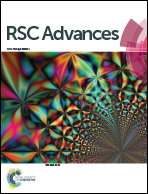Electrospun H4SiW12O40/chitosan/polycaprolactam sandwich nanofibrous membrane with excellent dual-function: adsorption and photocatalysis†
Abstract
For comprehensive treatment of wastewater, an electrospun H4SiW12O40 (SiW12)/chitosan (CS)/polycaprolactam (PA6) sandwich nanofibrous membrane (SNM) with dual-functions of adsorption and photocatalysis was prepared to remove Cr(VI) and methyl orange (MO) from aqueous solution. The three layers of the SNM had good compatibility and thus no visible stratification phenomenon was observed in the SNM. Taking advantage of the merits of high porosity, good hydrophilicity, robust mechanical strength and superior water tolerance, the obtained SNM presented an excellent comprehensive performance with high adsorption capacity toward Cr(VI) (78.5 mg g−1), high photodegradation efficiency toward MO (96.7%) and good reusability. Based on the images of the SNM after Cr(VI) adsorption, the SiW12/PA6 layer (upper and bottom layer) was not affected in the adsorption process, which was consistent with our initial design. XPS analysis was carried out to investigate the mechanism of adsorption and photocatalysis. In the adsorption process, Cr(VI) was initially adsorbed on the CS/PA6 layer (intermediate layer), followed by the reduction of Cr(VI) to Cr(III) by the –NH2 of CS. The photocatalytic process was driven by the reductive pathway with faster degradation rate due to the electron donation from PA6 to SiW12. Although Cr(III) at the layer boundary was involved in the photocatalytic process, the photocatalytic activity of the SiW12/PA6 layer was almost not influenced. This work may provide a new and effective strategy to construct multifunctional nanofibrous membranes for the comprehensive treatment of wastewater.



 Please wait while we load your content...
Please wait while we load your content...